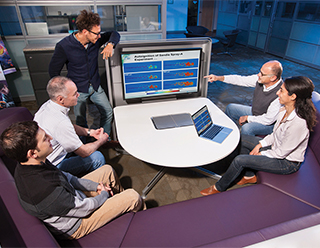
When UQ met LES — Mohammad Khalil, Joseph Oefelein, Guilhem Lacaze, Layal Hakim, and Habib Najm (all 8351), researchers at Sandia’s Combustion Research Facility, are applying Uncertainty Quantification (UQ) principles to Large Eddy Simulations (LES) to create simpler combustion models. Here the team discusses results for a project on statistical calibration of simplified chemical mechanisms for diesel engine combustion. (Photo by Randy Wong)
For years, US automakers have been customizing the generic combustion process models from Sandia’s Combustion Research Facility (CRF) to design cleaner and more efficient engines for cars and trucks. To support this process — essential to a sustainable energy future — CRF researchers are constantly seeking to make these basic models not only more accurate and reliable, but easier and faster for industry to use.
This is no small task.
The problem lies in combustion chemistry’s notorious complexity and its interplay with flow turbulence, which encompasses thousands of coupled reactions that must be described over large ranges of pressure and temperature. Further, the chemical concentrations must often be resolved down to parts-per-billion levels for different pollutant species. It’s little wonder, then, that equations that describe the physics of combustion may take a year or more to solve using a high-performance supercomputer — a scale of computing resources that is simply not viable for the private sector.
“The CRF has a lot of experience in developing combustion models that provide accurate and reliable results,” says Joseph Oefelein, who with colleagues Layal Hakim and Guilhem Lacaze (all 8351), applies Large Eddy Simulation (LES) to mathematically model diverse combustion processes. “But now we have to distill new knowledge about combustion into models that can run even faster. Industry consistently makes the case that if a model takes more than a day to run, they can’t use it.”
Streamlining models with uncertainty quantification
The LES construct used by Joseph, Layal, and Guilhem resolves the larger energetic scales of a given flow and models the smaller-scale physics associated with combustion. This significantly reduces the computational burden of the combustion equations. However, LES is very sensitive to a variety of factors. A seemingly minor change to a key parameter can dramatically alter the model’s predictive accuracy. To overcome this challenge, the modelers consulted with fellow CRF scientists Habib Najm and Mohammad Khalil (both 8351), specialists in state-of-the-art application of Uncertainty Quantification (UQ).
Using UQ, this research team hopes to identify and better understand the portions of the LES model that are most sensitive to a design issue in question, such as the formation of soot or nitric oxide emissions within an engine. Instead of seeking a single result, UQ helps to characterize the range of results that occur from running aspects of the LES model multiple times with different values for key parameters. Analyzing the range enables researchers to determine which parameters are most sensitive and must be accounted for more accurately in the models and which are less sensitive and can be abbreviated or omitted. UQ then allows researchers to create a “surrogate” model — a simpler version of the full LES model that captures the essential elements, yielding useful answers while cutting computational time and costs.
So far, the LES-UQ team has demonstrated the feasibility of UQ’s application to LES using the well-studied Sydney bluff-body HM1 flame as a test platform. “By using Bayesian inference methods, we are able to propagate uncertainty through the simulations and understand the effects of various simulation inputs on predicted quantities of interest, such as engine performance and emissions characteristics,” says Guilhem.
This example has fueled the team’s confidence that UQ can dramatically reduce combustion simulation complexity, and therefore runtime, while retaining a useful level of accuracy. The effort has now been extended to include a focus on statistical calibration of simplified chemical mechanisms for diesel engine combustion.
Making multidisciplinary teams work
Multidisciplinary teams have become a reality of the modern world — but working effectively with people in different fields, with different expertise, can be challenging. Joseph credits some of the success of the combined LES-UQ team to experience. “The more we collaborate, the better we understand the optimal interface between various areas of expertise and thus how to share the workflow between team members.”
Also working in the team’s favor is the fact that the UQ techniques being developed are nonintrusive — that is, they do not require changes to the complex simulation code to which they are being applied. Thus, UQ has widespread applicability, from chemistry to materials science to nuclear engineering. Habib finds experience in other fields informs his intuition for applying UQ to LES. “Fortunately, I don’t have to rely solely on experiments in combustion areas. UQ research in entirely different fields is helping me expedite UQ’s application to Large Eddy Simulation.”
Finally Joseph points to the advantages of co-location. “Our workspaces are all close to each other, so it’s easy to get together to talk about ideas and what’s working or not on a near-daily basis. Sometimes all we need is a quick discussion in the hallway to move to the next step.”
For this team, next steps are numerous: acquiring a better understanding of the range of errors that can affect LES itself, regardless of UQ use; decoupling numerical and model errors; quantifying the cold-flow versus combustion attributes of scalar mixing; testing the UQ approach on different flame types; and testing the approach using different LES codes.
The team is optimistic, anticipating that in just a couple of years, this marriage of UQ with LES will be ready for much more routine application. The improved simulation capability couldn’t come at a better time for automakers, who are attempting to implement advanced, low-temperature combustion engine designs. Further, CRF expects its techniques for applying UQ to LES to bear fruit not just throughout the transportation sector — cars, trucks, buses, rail, jets — but in any industry employing computational fluid dynamics.